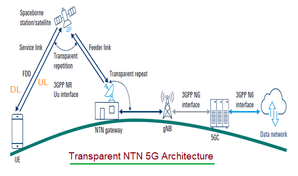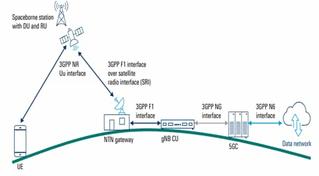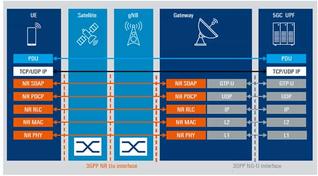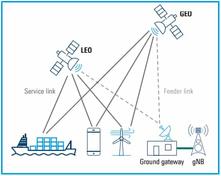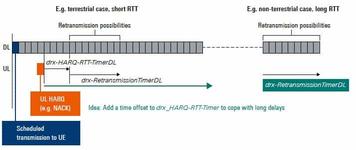HARQ in 5G NTN: Retransmission Strategies for Satellite Links
Advertisement
Standard HARQ and its function
HARQ is a fundamental feature of modern wireless communication that provides fast and efficient error correction at the MAC layer. It works on a “stop-and-wait” basis for each of its parallel processes. The transmitter sends a packet of data (a Transport Block) and then waits for a very quick acknowledgment (ACK) or negative acknowledgment (NACK) from the receiver.
- If an ACK is received, the transmitter sends the next new data packet in that process.
- If a NACK is received, it retransmits the previous packet, often with different redundancy information to improve the chance of success.
Challenges of HARQ in 5G NTN
The standard HARQ mechanism relies on feedback arriving within a few milliseconds. In NTN, the Round-Trip Time (RTT) can be up to 50 ms for LEO and nearly 600 ms for GEO.
5G NR uses up to 16 parallel HARQ processes. With such a long RTT, all 16 processes would transmit their first packet and then get “stuck” waiting for the ACK/NACK feedback. No new data could be sent until the first acknowledgments arrived, completely stalling the data transmission.
For GEO constellation, hundreds of HARQ processes would be needed to keep the data pipe full, which is unfeasible due to memory and hardware limitations on the UE.
HARQ implementation in 5G NTN
3GPP introduced three main adaptations for the HARQ implementation, allowing the network to choose the best strategy for a given scenario.
- Extending the Number of HARQ Processes
- Implementation: The maximum number of parallel HARQ processes is doubled from 16 to 32.
- How it Works: By having more parallel “pipelines,” the transmitter can send out more data packets before the first acknowledgments start arriving back. This helps to keep the data flowing and avoids stalling, but only up to a certain RTT.
- Signaling: This is an optional UE capability. To support 32 processes, the HARQ Process ID field in the DCI (Downlink Control Information) scheduling message is extended from 4 bits (for 16 processes) to 5 bits.
- Limitation : while 32 processes are sufficient for LEO (which theoretically needs ~ 50), this solution is completely inadequate for GEO, which would need ~ 600 processes.
- Disabling HARQ Feedback
This is a more radical approach for handling very long delays, especially in GEO scenarios.
- Implementation: The network can configure the UE to completely disable the transmission of ACK/NACK feedback for specific HARQ processes. This is configured via an RRC parameter (HARQ-feedbackEnabling-disablingperHARQprocess).
- How it Works: The transmitter sends a packet and, without waiting for feedback, becomes immediately free to use that HARQ process to send a new data packet. This completely solves the stalling problem.
- The Trade-off: Disabling HARQ removes the fast error correction at the MAC layer. To maintain a reliable connection, the responsibility for error detection and retransmission is shifted up the protocol stack to the RLC (Radio Link Control) layer in Acknowledged Mode. This is less efficient and adds more latency to retransmissions, but it keeps the data flowing.
- Configuration of Automatic Retransmission (Blind Retransmission)
This is a middle ground solution that improves reliability without relying on feedback.
- Implementation: The network can instruct the transmitter to automatically retransmit a data packet one or more times, without waiting for a NACK. This is similar to a legacy feature called “TTI Bundling.”
- How it Works: The transmitter sends the first version of a packet (e.g., RV0) and then, after a configured delay, sends a second version (e.g., RV1) “blindly.” This increases the probability that the receiver can successfully decode the packet, even in poor signal conditions.
- The Trade-off: This method improves reliability but is inefficient, as it uses radio resources for a retransmission that might not have been necessary. As shown. it also has power consumption implications for DRX, as the UE must be awake to receive these retransmissions.
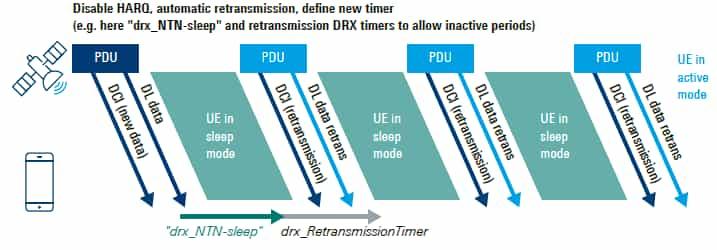 Image Courtesy : Rohde & Schwarz
Image Courtesy : Rohde & Schwarz
HARQ Timer Adaptations
To manage the timing of these new procedures, key timers are also adapted:
- HARQ Timer K1 and Koffset: To accommodate the long delay for feedback (when it is enabled), the response time for a HARQ ACK/NACK is extended. The PUCCH transmission carrying the feedback is deferred by the standard timer K1 plus an additional, NTN-specific timer called “Koffset”.
Summary: The 5G NTN HARQ implementation transforms the rigid, low latency HARQ system into a highly flexible mechanism. The network can choose between extending the process count for LEO, disabling feedback for GEO or using blind retransmissions for enhanced reliability, all while adapting the underlying timers to match the vast RTT of the satellite link.
Advertisement
 RF
RF